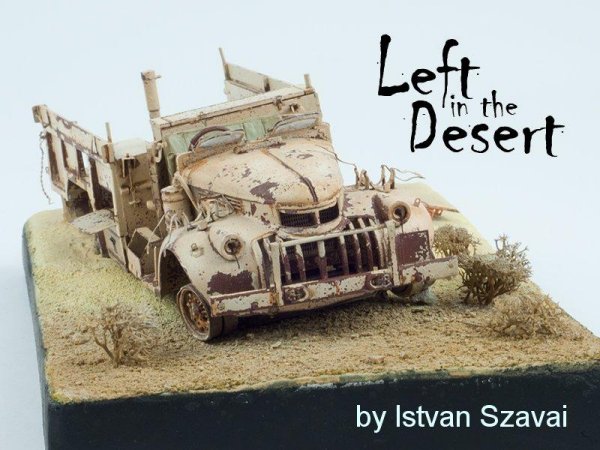1⁄35Left in the Desert
5
Comments
the backstory
The summer of 1991 was swelteringly hot. I was 16 and working in a labour camp, weeding corn in the endless fields down at the southern border of Hungary. On the other side of the border the battle for Osijek was raging. In the evenings we’d dance to the local hit sounds, while uncomfortably watching the lights painted on the horizon by the barrages of the Serbian artillery surrounding the big Croatian city. When I returned home after two weeks, I spent some of my hard earned money on Tamiya’s Chevrolet 30 cwt truck, my first 1:35 scale kit. I built it in a totally amateur way, but still loved it. After five years’ display on a shelf, it ended up in the spares box. That’s now many years ago, the Balkan wars are all over, and I’ve been away from modelling for more than a decade. On returning to the modelling scene, I started with small steps, trying out for myself some of the suprising number of new techniques that had been developed. The most thrilling for me was the famous hair-spray technique, and not long ago I finally decided to give it a try. Checking the spares box I found that good old Chevy. It was originally painted by hand with Tamiya acrylics, so the paint definitely had to come off. The old wheels were not in great shape, but as I was planning a wreck that wasn’t a problem. The only upgrade used in this current build is the Eduard photoetched set. My search for references produced two suprising facts. Firstly, I never realised that so many wrecks were left in the desert after World War II, and secondly, that many are in very good condition. I guess the vehicles were too far from civilization to salvage and sell as scrap. By contrast, in Hungary, literally every last piece of cartidge went into the smelter, so now our History of War Museum has only one fighting vehicle from that era, and it is still being renovated… My idea was to represent a vehicle, which had suffered serious, irreparable damage, like a broken chassis, or something, and so was left to the desert. It probably wasn’t with the LRDG, as they would burn any vehicles they were forced to abandon, but maybe it survived the war, and was then in service with an African army, or perhaps was being used by civilian traders when it had its final breakdown. A mysterious story, isn’t it?Comments
DEC 26, 2011 - 08:25 PM
Very nicely done! The only thing which I think is a bit too "perfect" is the front seats, after so much time in the desert the upholstery should have gone (there are not only sandstorms but animals as well, eager to get some fillings into their nests). But aside from this it is very convincing.
Phil: thank you for the links of the ANZAC expedition!
DEC 27, 2011 - 07:48 PM
Very well done Istvan - amazing what can be done with an old model with some ingenuity and good modelling techniques.
JUL 02, 2012 - 09:25 AM
Copyright ©2021 by Istvan Szavai. Images and/or videos also by copyright holder unless otherwise noted. The views and opinions expressed herein are solely the views and opinions of the authors and/or contributors to this Web site and do not necessarily represent the views and/or opinions of Armorama, KitMaker Network, or Silver Star Enterrpises. All rights reserved. Originally published on: 2011-12-19 00:00:00. Unique Reads: 15551

























